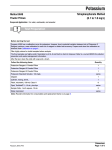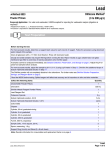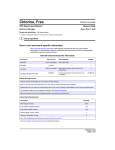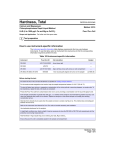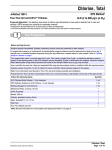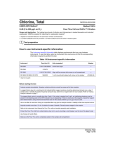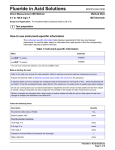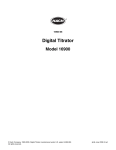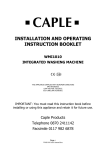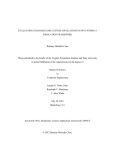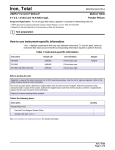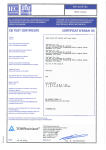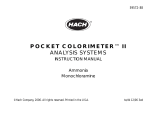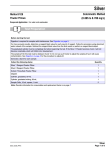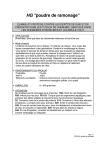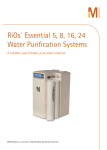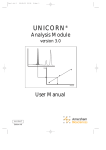Download Method 8038
Transcript
Nitrogen, Ammonia (Method 8038 Nessler Method1 (0.02 to 2.50 mg/L NH3–N) Scope and Application: For water, wastewater, and seawater; distillation is required for wastewater and seawater; USEPA accepted for wastewater analysis (distillation required); see Distillation on page 4 of this procedure. 1 Adapted from Standard Methods for the Examination of Water and Wastewater 4500-NH3 B & C. Test Preparation Before starting the test: For more accurate results, determine a reagent blank value for each new lot of reagent. Follow the procedure using deionized water instead of the sample. Subtract the reagent blank value from the final results or perform a reagent blank adjust. See the user manual for more information. Nessler Reagent contains mercuric iodide. Both the sample and the blank will contain mercury (D009) at a concentration regulated as a hazardous waste by the Federal RCRA. Do not pour these solutions down the drain. Refer to a current MSDS for safe disposal and handling instructions. If using the Pour-Thru Cell, periodically clean the cells by pouring a few sodium thiosulfate pentahydrate crystals into the cell funnel. Flush with enough deionized water to dissolve. Rinse the cell thoroughly. Collect the following items: Quantity Ammonia Nitrogen Reagent set 1 Deionized Water 25 mL Graduated Mixing Cylinders 2 Sample Cells, 1-inch square, 10-mL 2 Serological Pipet, 1-mL 2 Note: Reorder information for consumables and replacement items is on page 5. Note: Nessler Reagent is toxic and corrosive. Pipet carefully, using a pipet filler. When dispensing reagent from a dropper bottle, hold the bottle vertically. Do not hold the bottle at an angle. Note: A yellow color will develop if ammonia is present. (The reagent will cause a faint yellow color in the blank.) Nessler Method 8038 L FIL E LIN 1. Select the test. NitrogenAmm_8038_NES.fm 2. Insert the Multi-cell Adapter with the 1-inch square cell holder facing the user. 3. Prepared Sample: Fill a 25-mL mixing graduated cylinder to the 25-mL mark with sample. 4. Blank Preparation: Fill a 25-mL mixing graduated cylinder to the 25-mL mark with deionized water. Nitrogen, Ammonia Page 1 of 6 Nitrogen, Ammonia (0.02 to 2.50 mg/L NH3–N) 5. Add three drops of Mineral Stabilizer to each cylinder. Stopper and invert several times to mix. 6. Add three drops of Polyvinyl Alcohol Dispersing Agent to each cylinder. Stopper and invert several times to mix. 7. Pipet 1.0 mL of Nessler Reagent into each cylinder. Stopper and invert several times to mix. 9. Pour 10 mL of each solution into a square sample cell. 10. When the timer expires, insert the blank into the cell holder with the fill line facing the user. Press ZERO. The display will show: 0.00 mg/L NH3 –N 11. Wipe the prepared sample and insert it into the cell holder with the fill line facing the user. 8. Press TIMER>OK. A one-minute reaction period will begin. Results are in mg/L NH3–N. Interferences Table 1 Interfering Substances and Levels Interfering Substance Interference Levels and Treatments Chlorine Remove residual chlorine by adding 2 drops of sodium arsenite for each mg/L chlorine (Cl2) from a 250 mL sample. Sodium thiosulfate can be used instead of sodium arsenite. See Sample Collection, Storage, and Preservation. Hardness A solution containing a mixture of 500 mg/L CaCO3 and 500 mg/L Mg as CaCO3 does not interfere. If the hardness concentration exceeds these concentrations, add extra Mineral Stabilizer. Iron Interferes at all levels by causing turbidity with Nessler Reagent. Seawater May be analyzed by adding of 1.0 mL (27 drops) of Mineral Stabilizer to the sample before analysis. This complexes the high magnesium concentrations found in sea water, but the sensitivity of the test is reduced by 30 percent due to the high chloride concentration. For best results, perform a calibration, using standards spiked to the equivalent chloride concentration, or distill the sample as described below. Sulfide Interferes at all levels by causing turbidity with Nessler Reagent. Nitrogen, Ammonia Page 2 of 6 NitrogenAmm_8038_NES.fm Nitrogen, Ammonia (0.02 to 2.50 mg/L NH3–N) Table 1 Interfering Substances and Levels (continued) Interfering Substance Interference Levels and Treatments Glycine, various aliphatic and aromatic amines, organic chloramines, acetone, aldehydes and alcohols May cause greenish or other off colors or turbidity. Distill the sample if these compounds are present. Sample Collection, Storage, and Preservation Collect samples in clean glass or plastic bottles. If chlorine is present, add one drop of 0.1 N Sodium Thiosulfate* for each 0.3 mg/L Cl2 in a 1-liter sample. Preserve the sample by reducing the pH to 2 or less with sulfuric acid (at least 2 mL). Store at 4 °C (39 °F) or less. Preserved samples may be stored up to 28 days. Warm samples to room temperature and neutralize with 5 N Sodium Hydroxide* before analysis. Correct the test result for volume additions. Accuracy Check Standard Additions Method (Sample Spike) 1. After reading test results, leave the sample cell (unspiked sample) in the instrument. 2. Press OPTIONS>MORE. Press STANDARD ADDITIONS. A summary of the standard additions procedure will appear. 3. Press OK to accept the default values for standard concentration, sample volume, and spike volumes. Press EDIT to change these values. After values are accepted, the unspiked sample reading will appear in the top row. See the user manual for more information. 4. Snap the neck off a Nitrogen Ammonia Voluette® Ampule Standard, 50-mg/L NH3–N. 5. Prepare three sample spikes. Fill three mixing cylinders with 25 mL of sample. Use the TenSette® Pipet to add 0.1 mL, 0.2 mL, and 0.3 mL of the 50 mg/L standard, respectively, to each sample and mix thoroughly. 6. Analyze each sample spike as described in the procedure above, starting with the 0.1 mL sample spike. Accept each standard additions reading by pressing READ. Each addition should reflect approximately 100% recovery. 7. After completing the sequence, press GRAPH to view the best-fit line through the standard additions data points, accounting for the matrix interferences. Press IDEAL LINE to view the relationship between the sample spikes and the "Ideal Line" of 100% recovery. Standard Solutions Method 1. To check accuracy, use a 1.0-mg/L Nitrogen Ammonia Standard Solution. Or, prepare a 1.0-mg/L ammonia nitrogen standard solution by pipetting 1.00 mL of Nitrogen Ammonia Voluette® Ampule Standard, 50-mg/L, into a 50-mL volumetric flask. Dilute to the mark with deionized water. Prepare this solution daily. Perform the Nessler procedure as described above. 2. To adjust the calibration curve using the reading obtained with the standard solution, press OPTIONS>MORE on the current program menu. Press STANDARD ADJUST. * See Optional Reagents and Apparatus on page 5. NitrogenAmm_8038_NES.fm Nitrogen, Ammonia Page 3 of 6 Nitrogen, Ammonia (0.02 to 2.50 mg/L NH3–N) 3. Press ON. Press ADJUST to accept the displayed concentration. If an alternate concentration is used, press the number in the box to enter the actual concentration, then press OK. Press ADJUST. Method Performance Precision Standard: 1.00 mg/L NH3–N Program 95% Confidence Limits of Distribution 380 0.99–1.01 mg/L NH3 –N Sensitivity Portion of Curve ∆Abs ∆Concentration Entire range 0.010 0.02 mg/L NH3 –N2 Distillation 1. Measure 250 mL of sample into a 250-mL graduated cylinder and pour into a 400-mL beaker. Destroy chlorine, if necessary, by adding 2 drops of Sodium Arsenite Solution per mg/L Cl2. 2. Add 25 mL of Borate Buffer Solution and mix. Adjust the pH to about 9.5 with 1 N sodium hydroxide solution. Use a pH meter. 3. Set up the General Purpose Distillation Apparatus as shown in the Distillation Apparatus Manual. Pour the solution into the distillation flask. Add a stir bar. 4. Use a graduated cylinder to measure 25 mL of deionized water into a 250-mL Erlenmeyer flask. Add the contents of one Boric Acid Powder Pillow. Mix thoroughly. Set the flask under the still drip tube. Elevate so the end of the tube is immersed in the solution. 5. Turn on the heater power switch. Set the stir control to 5 and the heat control to 10. Turn on the water and adjust to maintain a constant flow through the condenser. 6. Turn off the heater after collecting 150 mL of distillate. Immediately remove the collection flask to avoid sucking solution into the still. Measure the distillate to ensure 150 mL was collected (total volume = 175 mL). 7. Adjust the pH of the distillate to about 7 with 1 N sodium hydroxide. Use a pH meter. 8. Pour the distillate into a 250-mL volumetric flask; rinse the Erlenmeyer with deionized water. Add the rinsings to the volumetric flask. Dilute to the mark. Stopper. Mix thoroughly. Analyze as described above. Summary of Method The Mineral Stabilizer complexes hardness in the sample. The Polyvinyl Alcohol Dispersing Agent aids the color formation in the reaction of Nessler Reagent with ammonium ions. A yellow color is formed proportional to the ammonia concentration. Test results are measured at 425 nm. Nitrogen, Ammonia Page 4 of 6 NitrogenAmm_8038_NES.fm Nitrogen, Ammonia (0.02 to 2.50 mg/L NH3–N) Consumables and Replacement Items Required Reagents Description Quantity/Test Unit Cat. No. — — 24582-00 Nessler Reagent 2 mL 500 mL 21194-49 Mineral Stabilizer 6 drops 50 mL SCDB 23766-26 Polyvinyl Alcohol Dispersing Agent 6 drops 50 mL SCDB 23765-26 25 mL 4L 272-56 Ammonia Nitrogen Reagent Set, includes: Water, deionized Required Apparatus Description Quantity/Test Unit Cat. No. Cylinder, graduated, mixing, 25-mL 2 each 20886-40 Pipet, serological, 1-mL 2 each 9190-02 Pipet Filler, safety bulb 1 each 14651-00 Sample Cells, 1-inch square, 10-mL, matched pair 2 2/pkg 24954-02 Unit Cat. No. Recommended Standards and Apparatus Description Flask, volumetric, Class A, 50 mL Nitrogen, Ammonia Standard Solution, 1-mg/L NH3–N Nitrogen, Ammonia Standard Solution, 10-mL Pipet, TenSette® Voluette® Ampule, 50-mg/L NH3–N 0.1 - 1.0 mL each 14574-41 500 mL 1891-49 16/pkg 14791-10 each 19700-01 Pipet Tips, for TenSette Pipet 19700-01 50/pkg 21856-96 Pipet Tips, for TenSette Pipet 19700-01 1000/pkg 21856-28 each 14515-35 500 mL 28332-49 Pipet, volumetric, Class A, 1.00 mL Wastewater, Effluent Inorganics, for NH3–N, NO3–N, PO4, COD, SO4, TOC Optional Reagents and Apparatus Description Cat. No. Distillation Apparatus, General 22653-00 Heater and Support Apparatus, 115 VAC, 60 Hz 22744-00 Heater and Support Apparatus, 230 VAC, 50 Hz 22744-02 Mixing Cylinders 20886-40 Pour-Thru Cell Kit LZV479 Sodium Thiosulfate, 0.1 N 323-32 Sodium Hydroxide, 5 N 2450-32 NitrogenAmm_8038_NES.fm Nitrogen, Ammonia Page 5 of 6 FOR TECHNICAL ASSISTANCE, PRICE INFORMATION AND ORDERING: In the U.S.A. – Call toll-free 800-227-4224 Outside the U.S.A. – Contact the HACH office or distributor serving you. On the Worldwide Web – www.hach.com; E-mail – [email protected] © Hach Company, 2005. All rights reserved. Printed in Germany. HACH COMPANY WORLD HEADQUARTERS Telephone: (970) 669-3050 FAX: (970) 669-2932 Updated April 05 Edition 1






